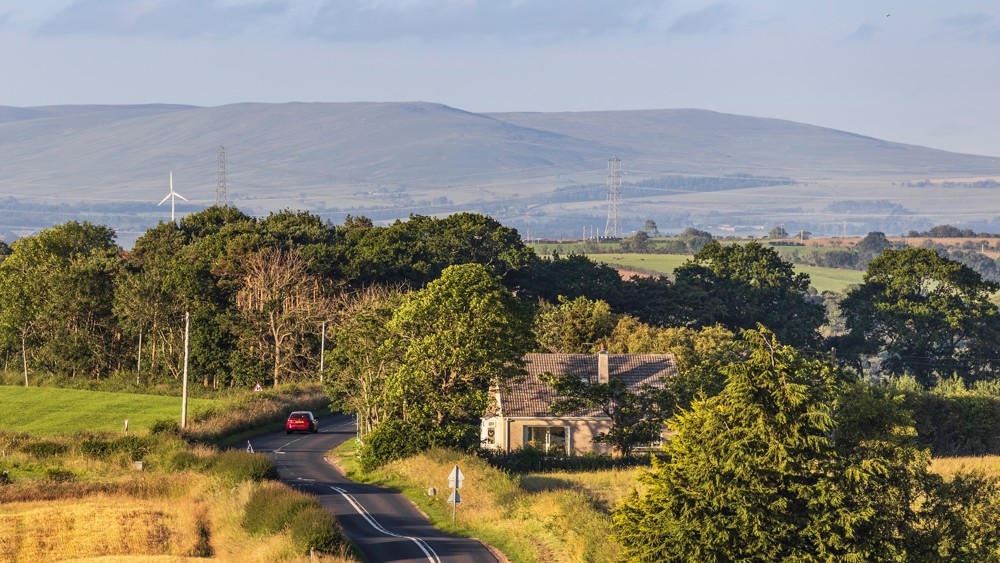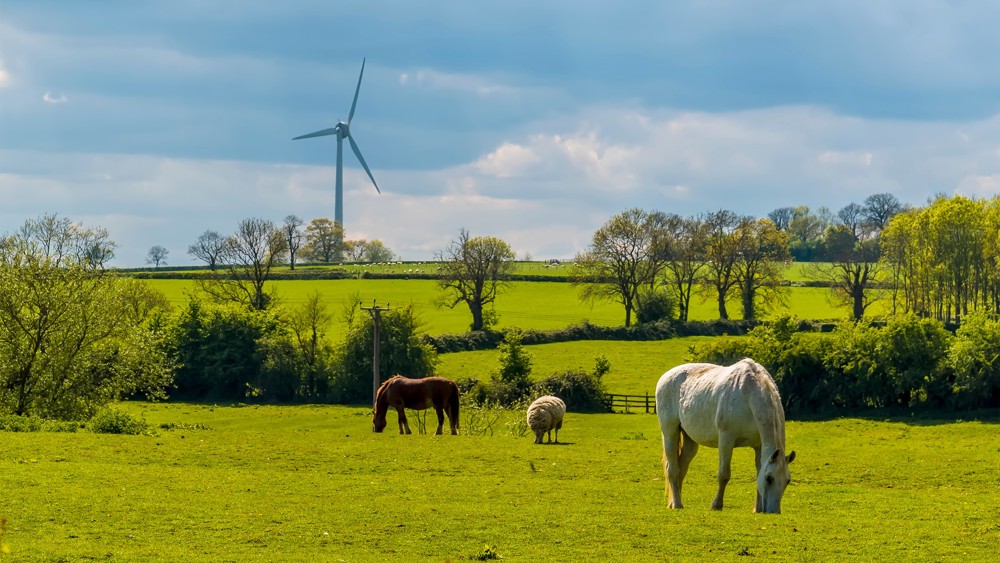Sam Sheppard, Senior Communications and Campaigns Manager
02/07/2025 | Onshore wind


Do wind farms affect house prices?
2 July 2025
As the UK rapidly decarbonises and transitions to a clean power system dominated by renewable sources of energy in the coming years, both onshore and offshore wind farms are an increasingly common sight across the country. For rural communities near these developments, there can be understandable concerns due to the size and visibility of a wind turbine, or indeed a steel pylon and its corresponding overhead power lines.
A common objection raised to wind farm developments, as well as associated grid infrastructure, centres on their potential impact on nearby house prices. Concerns that wind farms reduce the value of nearby homes are frequently raised, but are they supported by actual data?

What does the research tell us?
One of the first studies of this question was conducted by the independent Centre for Economics and Business Research (Cebr) in 2014. By examining Land Registry data covering more than 82,000 property transactions from 1995 to 2013, all within a five kilometre radius of seven wind farms throughout England and Wales, Cebr was able to analyse whether house prices were affected at every key stage of development – from before plans were announced, through the construction process, and into the years after the wind farm had been completed.
The study found that local house prices in areas with wind farms continued to perform as would have been expected in the absence of wind farms. Prices tracked the county average, with no evidence of a downturn which could be attributed to the presence or absence of the wind farm. Rather, prices continued to be affected by wider macroeconomic factors such as local employment opportunities, the state of the housing market overall, and the nationwide economic cycle of growth and recession.
Following this, in 2016 the Scottish Government commissioned research and policy centre ClimateXChange to conduct a study looking impacts on house prices from wind farm developments across Scotland. Led by a team from Sheffield University, the project set out to test whether there was a significant difference in the average house price growth of properties in close proximity to a wind farm, as compared to properties that were not. The analysis considered the dates when individual turbines become operational, thereby taking into account the before and aftereffects of their construction.
Encompassing data for the whole of mainland Scotland from 1990 to 2014, the study looked at the impact of both single turbines and whole wind farms. Crucially, the findings did not point to a consistent pattern of impact, with the data showing that being situated near a wind farm had no consistent negative effects on house price growth. Similarly to Cebr’s earlier study, the lack of a consistent pattern highlighted the range of simultaneous factors that affect house prices, and the degree to which this varies across different locations.
Correspondingly, a 2024 study by BiGGAR Economics looked at house price trends of properties in close proximity to Scotland’s Beauly-Denny electricity transmission line, which runs overhead for more than 130 miles from north of Inverness to near Falkirk. The study examined house prices along the Beauly-Denny route since it became operational in 2015, finding that they had mirrored wider trends of the four local authority areas it passes through. Since 2015, house prices have surged across the local authorities of Highland, Perth and Kinross, Stirling, and Falkirk, with properties along the Beauly-Denny power line matching this growth. A similar rate of growth can be seen in house prices across South Lanarkshire, East Renfrewshire and Dumfries and Galloway, all of which host a significant number of wind farms. This again suggests broader macroeconomic factors are the primary determinant of house prices, and that visible energy infrastructure does not have a prominent influence.
Looking overseas, we see the same patterns emerge. A 2014 study by the University of Guelph in Canada examined more than 7,000 home and farm sales in Ontario, near the site of the state’s first and largest wind farms, where 133 turbines were erected between 2005 and 2008. The study examined sales data over an eight-year period, from 2002 to 2010, to capture property values before, during and after the wind farm’s development. During that period, more than 1,000 homes and farms were resold, some multiple times, and the study found wind farms had no statistically significant effect on property values.

What about the visual impact?
There’s no getting around the fact that onshore wind turbines are hard to miss, given their height and size, and they are getting taller as technology improves and they are able to capture more wind energy at higher altitudes. However, it’s important to remember that the UK's planning system is strict when it comes to the visual and environmental impact of structures, and wind turbines are no exception to this. A given turbine's height, design, and location must adhere to specific criteria outlined by the local planning authority, whilst also producing minimal noise and being placed a certain distance from surrounding buildings and residences in order to be approved.
It is also worth noting that it can be difficult to visualise the impact of a wind turbine or wind farm, which can lead to fears born of uncertainty. Where developers are able to provide high-quality visual representations or mock-ups during the planning stages of a project, local communities will often feel reassured.
Are there benefits to living near a wind farm?
Aside from the importance of decarbonisation and energy security, as we transition to homegrown clean energy and move away from volatile and costly imported gas, wind energy directly supports both nature and local communities throughout the country. This is done through a range of initiatives such as community benefit funds (CBFs) for communities closest to onshore wind farms, local electricity discount schemes, and local or shared ownership models. Taking community benefits alone, RenewableUK estimates that more than £550 million has been locally invested through CBFs since 2015, and this figure is expected to rise to £150 million annually if Government ambitions to 2030 are met.
Working with Scottish Renewables, we have recently published a joint-report highlighting how the onshore wind industry engages with communities and delivers local benefits through CBFs across England, Scotland, Wales and Northern Ireland. This is the first such report to examine case studies from across the UK, demonstrating what ‘good’ community benefit looks like across a wide range of diverse schemes.
What explains the concerns?
Wind turbines provoke strong reactions because they are large and visually striking, but it’s important to note that their visual impact is often overstated during planning debates. Once built, they quickly (and quietly!) become part of the local landscape, whilst new buyers are aware of them before purchasing. Millions of homes are located near roads, overhead power lines, or railways without suffering a loss in value, and wind turbines are no different, especially given they are sited responsibly and built with extensive community consultation.
In many rural and semi-rural areas, the overall setting, transport links, schools, and amenities matter far more to house buyers than whether a turbine or wind farm is visible on the horizon. In fact, the growth of renewable energy is increasingly seen by many as a sign of regional investment and forward-thinking planning, rather than an intrusion by industry.
In conclusion
House prices are influenced by a wide range of complex macroeconomic factors - from prevailing financial conditions, to interest rates, school catchment areas, and job availability - all of which play far more significant roles than whether a wind farm is nearby. Looking at the available research, we simply do not see consistent evidence to support the idea that such developments negatively affect long-term property values in the UK.
Wind energy is the backbone of our future energy system, and it is something that homeowners, buyers, and local communities can embrace without financial fear.



